Out-of-the-box Sustainable Packaging Options for Manufacturers
By Jaan Koel | October 1, 2012
Category: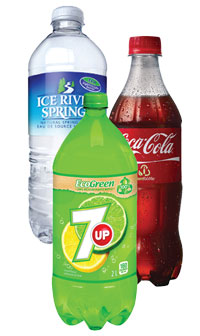
- Packaging manufacturers are light-weighting and downsizing plastic, corrugated cardboard, glass, and metal.
- Plastic bottlers are sourcing recycled PET plastic and bioresins.
- Adhesives, coatings, and inks have been reformulated to help containers become recyclable, biodegradable.
The packaging industry is under a lot of environmental pressure. An estimated 30 percent of landfill waste comprises packaging. Fortunately, some packaging manufacturers and users have taken important steps to improve packaging performance and minimize its end-of-life and other ecoimpacts.
Sustainability continues to grow in importance. According to a 2011 DuPont global survey of consumer packaged goods companies and packaging converters, 39 percent of the 500 respondents view sustainability as the No. 1 issue, and 65 percent said their focus was on design for recyclability or use of recycled content.
Among the most important trends in packaging today—from a regulatory perspective, at least—is extended producer responsibility (EPR), according to Jim Downham, president of The Packaging Association of Canada. Governments in Europe and Canada have been at the forefront in introducing EPR legislation as a tool to drive packaging material reduction, increase recovery, lessen landfill volume, and promote energy conservation. EPR also is being introduced more and more in the U.S. by state governments.
EPR’s basic concept is making producers and users of packaging financially responsible for managing its end-of-life by paying fees and setting up industry funding organizations (IFOs) to pay for the collection and recycling of packaging they use to sell their products.
The list of sustainable packaging options for manufacturers to make better ecochoices is getting longer in more sectors all the time. These choices are based on numerous criteria, all of which are based on scientific metrics and common sense: light-weighting and downsizing; material recovery and recycled content; recyclability; and biodegradability and the use of plant-based materials. In addition, packaging manufacturers are implementing practices designed to reduce greenhouse gas emissions, energy usage, and waste and to improve their companies’ economics and work environments.
Light-weighting, Downsizing
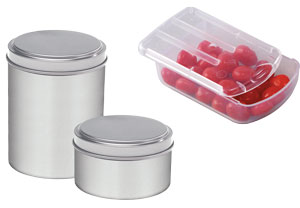
Figure 1
J.L. Clark has reduced wall thicknesses of both its metal and plastic containers. The impact on manufacturing costs, shipping costs, and material savings is significant.
A significant technical trend has been light-weighting in all major sectors: plastic, corrugated cardboard, glass, and metal, Downham said. Downsizing is widespread because it’s the lowest-hanging fruit in most cases, providing immediate environmental benefits as well as contributions to the bottom line. “Product-to-package ratio is very important, resulting in less overpackaging,” he said.
For more than 100 years, J.L. Clark has been a marketplace leader in developing metal containers for all types of consumer packaging. The company now specializes not only in fabricating and decorating tin cans, but also in injection molding plastic packaging (see Figure 1). The company has two plants, one in Rockford, Ill., and the other in Lancaster, Pa.
“We’re working to ‘down-weight’ our metal structures wherever possible to take weight out of each container, thus making a significant impact on energy costs and greenhouse gas emissions downstream,” said President Phil Baerenwald. “We’ve managed to reduce from a 75-lb.-wall to 65-lb.-wall thickness in our steel packaging. It’s really only a few ten thousandths of an inch difference, but it’s a big saving over large runs.
“We’ve also reduced our polypropylene wall thickness wherever possible,” Baerenwald continued. “A plastic container that uses 35 percent less material requires 30 percent less energy to produce and weighs less, reducing fuel costs for shipping.
“The challenge is to make sure our packages aren’t perceived as too flimsy, but we’ve been able to design them so consumers or customers don’t see a difference,” he added.
Other companies, such as Packsize of Salt Lake City, are doing some very innovative things to downsize corrugated cardboard packaging (see Figure 2). The company has developed a manufacturing and distribution system that provides accurately sized, customized boxes for each product just-in-time. Reducing package sizes to fit the product results in cost savings from 20 to 30 percent for the company.
“Rightsizing,” as the company describes its approach, results in less packaging and packing material waste, lower shipping costs, decreased damage rates, less “air” or dimensional weight charges in transport, and customer satisfaction.
The company installs forming machines at customer plants and provides continuous-feed sheets of specially configured corrugate that runs through them to output made-to-measure boxes tailor-fit to a specific product—no wasted space, no unnecessary fill—one-off or dozens or hundreds at a time. This approach is suitable for manufacturers that have a diverse range of products that require a range of box sizes, said Packsize President Hanko Kiessner.
Some downsizing approaches have eliminated one type of packaging for another, smaller, ecofriendly one. For example, an ecofriendly replacement for plastic shrinkwrapping corrugated boxes on pallets is rubber pallet bands (see Figure 3). John Kasman, CEO of Tinley Park, Ill.-based Aero Rubber, said the company’s pallet bands stabilize pallet loads without plastic shrinkwrap. The natural rubber pallet bands are reusable and recyclable.
Yet another packaging approach eliminates part of the packaging altogether. Georgia-Pacific, Atlanta, redesigned its bathroom tissue to eliminate the cardboard core. The Compact® system eliminates 95 percent of the packaging waste associated with standard bath tissue. Each case of Compact coreless bath tissue prevents 8.5 lbs. of waste from becoming landfill-deposited.
Waste Material Recovery, Recycled Content

Figure 3
Aero Rubber’s reusable and recyclable natural rubber pallet bands replace nonrecyclable plastic shrinkwrap.
“In addition to light-weighting, the packaging industry in general has been shifting to more material recovery,” The Packaging Association’s Downham said. “This is being driven by an understanding that most recovered materials can replace virgin materials, resulting in landfill avoidance and huge energy savings, especially in aluminum recycling.”
PET. Pepsi has been doing a lot of cutting-edge things with recycled-content PET, Downham said. “Just over a year ago, PepsiCo’s Canadian division introduced a new pop bottle that it says is the first ever in North America to be made entirely from recycled PET plastic.”
Billed as the EcoGreen™ bottle, it became the first to be used in all the company’s 7UP® and Diet 7UP package sizes (see lead image).
“After three years of research and development, we have cracked the code to commercially develop a soft drink bottle made from 100 percent recycled PET plastic, and Canada has proudly led the way,” said Richard Glover, president of PepsiCo Beverages Canada.
Pepsi’s plastic bottles used to contain 10 percent recycled PET material. Switching to an all-recycled 7UP container has cut the use of new plastic at North American Pepsi factories by about 6 million lbs. a year.
The company stressed that the new bottle looks and feels like any other PET plastic soft drink bottle. Consumers don’t notice any difference, Pepsi said in a statement.
A Pepsi spokesman said the company is looking at introducing 100 percent recycled PET bottles for its other soda packaging as well, but that “at the moment the market does not produce enough recycled plastic to allow us to use it across all our brands.”
In Canada, Ice River Springs, Shelburne, Ont., became the first bottled water company in North America to manufacture its own resin using similar technology (see lead image). Since November 2010, the company has produced its resin from baled postconsumer plastic purchased from municipal recycling centers, thereby closing the loop and significantly reducing its carbon footprint.
The company’s trucks deliver drinking water in 100 percent recycled PET to stores, and backhaul used bottles to its plant in Shelburne.
Biodegradable and Recyclable Plant-based Polymers
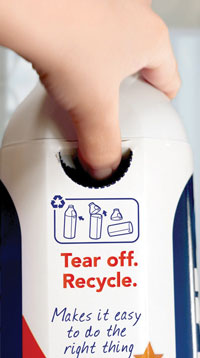
Figure 4
The Tetra Evero Aseptic separable top has a perforation in the cardboard that allows the polyethylene top to be separated from the carton sleeve. This delivers improved environmental characteristics by making it easy for consumers to separate the top from the carton sleeve and recycle them separately.
Downham noted that one of the most significant current technological trends in packaging is the development of plant-based polymers that can be recovered and recycled with fossil fuel-based polymers. “The most visible example is Coca-Cola’s PlantBottle,” he said (see lead image).
Coca-Cola is using 30 percent of its PlantBottle material in some of its soft drink bottles and intends to gradually increase that percentage to 100. Meanwhile, P&G’s Pantene® shampoo bottle and Heinz®’s ketchup bottle also use this material. Nike and Ford have plans to use it too.
NatureWorks LLC of Blair, Neb., has developed PLA (polylactic acid) sugar-based polymer called Ingeo™, which appears to be a good product with a lot of potential. The drawback is that it cannot be recycled with traditional fossil fuel plastics so it needs to be collected separately from other plastics and processed on its own.
NatureWorks is an independent company that Cargill and PTT Global Chemical have invested in to the tune of $150 million. The company’s Nebraska plant has a capacity of 140,000 metric tons. The company will soon build a second one in Thailand to meet increasing global market demand.
Tetra Pak, the world’s largest liquid food and food packaging company, recently introduced plant-based PET closures for a range of its carton packaging systems, with a view to developing more.
Following the successful launch of the Tetra Evero Aseptic,™ the world’s first aseptic carton bottle for white milk, Tetra Pak has pioneered another industry first by developing the additional functionality of a separable top (see Figure 4).
The separable top has a perforation in the cardboard that allows the separation of a polyethylene top from the carton sleeve, which improves recyclability by making it easy for consumers to recycle them separately. At no additional cost, the package helps strengthen its brand image and environmental profile in a highly competitive marketplace by addressing a consumer demand for better ways to facilitate recycling, the company says.
Ecofriendly Adhesives, Coatings Aid Recyclability, Biodegradability
Green Bay Packaging, Green Bay, Wis., specializes in corrugated packaging and operates two containerboard mills that produce linerboard and corrugated medium in the full spectrum of basis weights. The company’s Green Bay mill uses 100 percent postconsumer recycled fiber. The company’s Arkansas Mill uses both virgin and recycled fiber. Corrugated cardboard is also completely recyclable and biodegradable. More than 77 percent of corrugated containers is recovered for recycling.
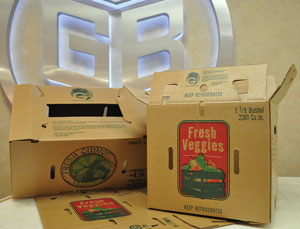
Figure 5
Green Bay Packaging’s alternative to wax-coated corrugated cartons for poultry, seafood, meat, and veggies converts packaging that would have been landfilled into a revenue-producing recyclable.
One thorn that had prevented containerboard packaging from being recyclable was its wax coating used to package poultry, vegetables, fresh meat, and seafood—until now. One of Green Bay Packaging’s most innovative products is ProGreen®, a recyclable alternative for nonrecyclable wax-coated cartons (see Figure 5). Being recyclable, the coating results in substantial cost savings and landfill reductions.
“Instead of having to pay $30 to $45 per ton to landfill wax-coated cartons, our customers can earn $80 to $125 per ton—based on the past year’s market—by selling them to a recycler instead,” said Lisa Bauer Lotto, director of environmental and sustainability programs. “This makes our customers more cost-effective and competitive.”
Global Green USA, a national environmental organization, estimates that wax alternatives have diverted 1.45 million tons of corrugated cardboard from landfills annually in the U.S., with a landfill fees savings of about $65 million, and $200 million total in earnings and savings, according to Bauer Lotto. “I think that’s actually an underestimate,” she added.
Sun Chemical, HB Fuller, and Henkel are all introducing water-soluble adhesives to enhance the recyclability of corrugated cardboard and other fibers.
DaniMer Scientific LLC has released a new biobased label adhesive specifically designed to achieve zero contamination and prevent clumping problems with PET recycling efforts.
Recyclable Steel. One point of pride J.L. Clark shares with other users of steel is that steel still is the most widely recycled material in the packaging market. One reason is that it’s magnetic, and so it can be easily separated from other materials at low cost in material recycling facilities.
The Triumvirate: Recycled Content, Recyclable, and Biodegradable
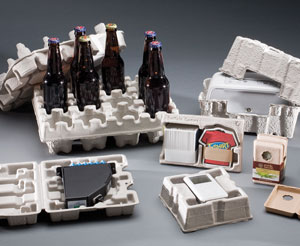
Figure 6
UFP Technologies has advanced the development of molded fiber packaging, made of recycled content and recyclable and biodegradable.
Molded Fiber. Molded fiber packaging is somewhat unique in the scheme of things. Not only is it highly recyclable, but it also has other environmental aspects that few others do: It is biodegradable and made from 100 percent recycled content—newsprint and water (see Figure 6).
UFP Technologies, Clinton, Iowa, has advanced the development of molded fiber packaging. Molded fiber now accounts for about 15 percent of the company’s revenues.
The process is based on the egg carton manufacturing process, but is considerably more sophisticated and diverse. Molded fiber packaging is made from 100 percent recycled newspaper, mixed into a slurry with water, and vacuum-formed on screened molds. Molded fiber’s natural resilience and blocking and bracing capabilities allow it to replace most vacuum-formed plastic, expanded polystyrene (EPS), and corrugated designs. The custom process reduces input and disposal costs compared to less recyclable, petroleum-based materials.
“We get our newspaper—clean No. 9 grade—from regional recyclers and then mix it up with water, form it, and dry it,” Sales and Marketing Director Steve McLaughlin said. The big-box stores—Wal-Mart, Target, and others—have been strong supporters of molded fiber for packaging because of the recyclability, McLaughlin said. “At one time, the rougher finish was not that desirable, but now it has an environmental appeal. That said, we’re also able to produce a two-sided smooth finish for more upscale products such as razors, computers, and candles.”
Manufacturers in markets from the wine and candle industries to health and beauty to consumer electronics are adopting sustainable molded fiber packaging. UFP recently developed a unique 12-bottle molded fiber wine shipper.
With an eye to the future, and considering the steady decline of newspaper volume, UFP is looking at future substitutes for pulp. “These include corrugated, wheat straw, bamboo, and sugar cane in a similar kind of production process, but we want to keep our supply as local as possible, not coming from 5,000 miles away,” noted McLaughlin.
Flexibility
Baerenwald said J.L. Clark has had to “reinvent” itself several times. “It’s usually a five-year cycle,” he said. “An example is the fitments we used to produce for SIG Combibloc aseptic cartons. When that market changed for us, we had to adjust and move forward with new innovations.”
He said that it’s an ongoing challenge. “We have to be in the right place at the right time. We’re not a commodity producer but a niche player. We can produce large orders as well, but we associate ourselves with innovative design and substrates.”
Baerenwald added that his company is not into bioplastics—yet—but that he sees this as an emerging option. “When demand increases, we will certainly offer it.
“We’re also continuing to invest in UV inks and coatings, using light rather than heat to dry inks,” he added. “Some UV coatings are not food-grade yet, but we’re trying to adapt decorating technology that uses more UV, which is more energy-efficient.”
Sustaining Sustainability
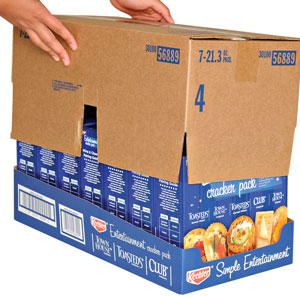
Figure 7
Green Bay Packaging’s retail-ready packaging cuts down on outer shipping cases, which also helps retailers achieve better turns at a lower cost at the store level.
Generally, producing sustainable packaging has dovetailed with incorporating other sustainable practices as well.
For example, Green Bay Packaging’s Green Bay plant has a sophisticated and first-of-its-kind closed-loop water recycling system in place that produces zero process discharge to the Fox River it sits beside. The company estimates that it has saved about 2.7 billion gallons of water as a result. In addition, its use of recycled materials, recycling, and other waste and energy consumption
reduction practices has diverted 395,702 tons of greenhouse gases and saved about 1.3 billion cubic yards of landfill space.
Another initiative Green Bay Packaging took on is retail-ready packaging (see Figure 7). This is a growing trend intended to reduce packaging content and waste in which manufacturers deliver their products to retailers in shelf-ready packages that are presentable, easy to open, and can be loaded onto the shelf by store staff.
“That’s another early innovation GBP brought to market for our customers,” said Bauer Lotto. “Retail-ready packaging can be more cost-effective than standard packaging and adds business value in the long run because it can eliminate outer shipping cases, enables faster product reshelves, and increases brand identity and sales in the store environment.”
Green Bay Packaging has its own forest resources and operates its own sawmill, according to Bauer Lotto. “We use 100 percent of our trees and have chosen to remain vertically integrated, owning more than 250,000 timberland acres to ensure sustainable fibersupply.”
Both of GBP’s mills are certified to Sustainable Forestry Initiative® (SFI®) standards, and the Green Bay mill is also Forest Stewardship Council® (FSC®)-certified. Part of earning that certification was the manufacturer’s planting of more than 5 million trees in 2011.
Many packaging system suppliers provide environmental and other support to their customers.
Georgia-Pacific has long been recognized for reducing waste and minimizing costs across all of its operations. It has developed a Packaging Systems Optimization (PSO™) program to help customers do the same thing—reduce costs, fiber consumption, greenhouse gas emissions, and overall energy use.
Georgia-Pacific also has its own environmentally certified forests and a huge corrugated business in the U.S. and elsewhere. Like Green Bay Packaging, the company released a moisture-resistant substitute for wax-coated corrugated called Greenshield®, which is fully recyclable in traditional corrugated streams.
J.L. Clark also makes a point of working with its suppliers to minimize waste. If a supplier ships something in a package or on a pallet that’s not recyclable or reusable, the company will ask the supplier to rethink and change; for example, pallets used to transport steel coils. “We don’t want them to go to landfill—they should be reused or recycled instead. That’s one aspect of our zero waste program,” Baerenwald said.
Maybe this kind of thinking can promote the use of reusable steel containers in the food, beverage, and other sectors that are now commonly used in the automotive industry. As reported in a story titled “Chassis builder achieves zero waste to landfill using reusable packaging” Freightliner Custom Chassis Corp. was able to reduce its landfill load to zero partly through the use of reusable steel containers for parts shipments from its suppliers. The containers come in with the parts, and then leave again for the next shipment. No more corrugated boxes, pallets, or extruded polystyrene, which until then were all landing in a landfill.
About a decade ago, J.L. Clark became a leader in using regenerative thermal oxidizer (RTO) technology for curing inks printed on metal. Others have since followed. The emissions-purifying technology oxidizes the volatile organic chemical emitted during the ink-curing process, rendering them harmless. A side benefit of the effort is that RTO has enabled the company to reduce its natural gas consumption ever since.
Consulting services to packaging consumers are no longer limited to the individual companies that produce packaging. One of many examples of successful firms that have been born as an outgrowth of sustainability in packaging is Green Sustainable Solutions LLC, Parkersburg, W.V.
This company specializes in helping customers achieve growth objectives while meeting their sustainability challenges and requirements. Its services include pallet management, product handling and movement, waste reduction, efficiency improvements, and reuse of expendable packaging.
Pressures continue for the packaging industry to improve its environmental performance. The great news is that the industry not only is responding, it is showing remarkable leadership.
More information about sustainable packaging is available below:
Aero Rubber Co., www.aerorubber.com
Coca-Cola, www.coca-cola.com
Georgia-Pacific, www.gp.com
Green Bay Packaging, www.gbp.com
Green Sustainable Solutions LLC, http://greenpak.com
Ice River Springs, www.iceriversprings.ca
J.L. Clark Inc., www.jlclark.com
NatureWorks LLC, www.natureworksllc.com
The Packaging Association, www.pac.ca
Packsize International LLC, www.packsize.com
PepsiCo, www.pepsico.com
Tetra Pak USA, www.tetrapak.com
UFP Technologies, www.ufpt.com

Side by side, we move metal fabrication forward.
FMA unites thousands of metal fabrication and manufacturing professionals around a common purpose: to shape the future of our industry, and in turn shape the world.
Learn More About FMA


